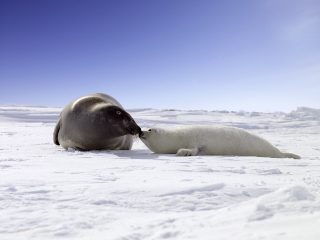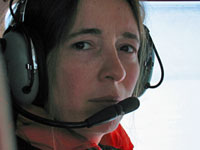

How baby seals become easy prey for hunters
Each spring, hundreds of thousands of female harp seals travel from Greenland, gathering on the ice floes in the Gulf of St. Lawrence. From late February until mid-March, mothers give birth to their pups, transforming the once-barren ice into a massive nursery set in tones of whites, pale greys and blues.
The pups are nursed with their mothers’ high-fat milk until they are about 12 days old, giving them enough blubber to survive when they are abandoned and learning how to feed themselves. Their mothers leave them to join adult males for the annual mating ritual.
Hunters used to be allowed to slaughter the pups when they were still snowy white and snuggling beside their mothers. But skinning them alive while their mothers looked on in panic was a public relations disaster for sealers. Now hunters have to wait until the pups are at least 12 days old, when their coats begin to molt to a silvery grey and their mothers have already gone.
The baby seals — still too young to swim — remain on the ice. They mew for their mothers at first, then grow quiet as they realize they have been left to fend for themselves. The silence is broken only by the creaking of the ice as the floating pieces rub and grind together.
These pups are called "beaters", but it’s not because of how they are killed. They are named for the way their fins beat the water as they try learning to swim.
That’s when the sealers descend upon the helpless pups and turn their icy paradise into a bloody scene rivaling the goriest horror movie. In fact they are closing in right now with boats, helicopters and snowmobiles, killing hundreds of thousands of baby seals. The men are armed with guns and spiked clubs called hakapiks that are used to smash the heads of the seals.
In 2001, an independent team of veterinary experts studied the bodies of animals killed during the hunt. In 42 percent of the cases, the seals didn’t show enough evidence of cranial injury to guarantee that they were even unconscious before being skinned alive.
Fully 95 percent of the harp seals killed over the past five years have been under three months of age.
They are utterly helpless and trusting, and wriggle right up to their killers with open curiosity.
GO ON THE SCENE WITH REBECCA
Rebecca Aldworth has been witnessing Canada’s seal hunt for 11 years. She’s also the director of Humane Society International Canada. You can follow what’s happening by clicking over to her Live from the Ice blog. She’s on scene documenting the hunt right now as it’s happening. She reports sealers are more aggressive to the unarmed, peaceful observers than ever before, threatening them with promises of "ricocheting bullets." A rifle was pointed at them, and four sealing boats repeatedly tried to ram their Zodiac.

Helicopter photo of Rebecca Aldworth courtesy of Humane Society of United States.
YOU CAN HELP END THE CRUELTY
The annual seal hunt is going on right now. To be part of stopping this atrocity for good, follow this link to the ProtectSeals campaign.
Carreen can be contacted at carreen@fuzzytown.com
Join the newsletter and never miss out on dog content again!
"*" indicates required fields
By clicking the arrow, you agree to our web Terms of Use and Privacy & Cookie Policy. Easy unsubscribe links are provided in every email.